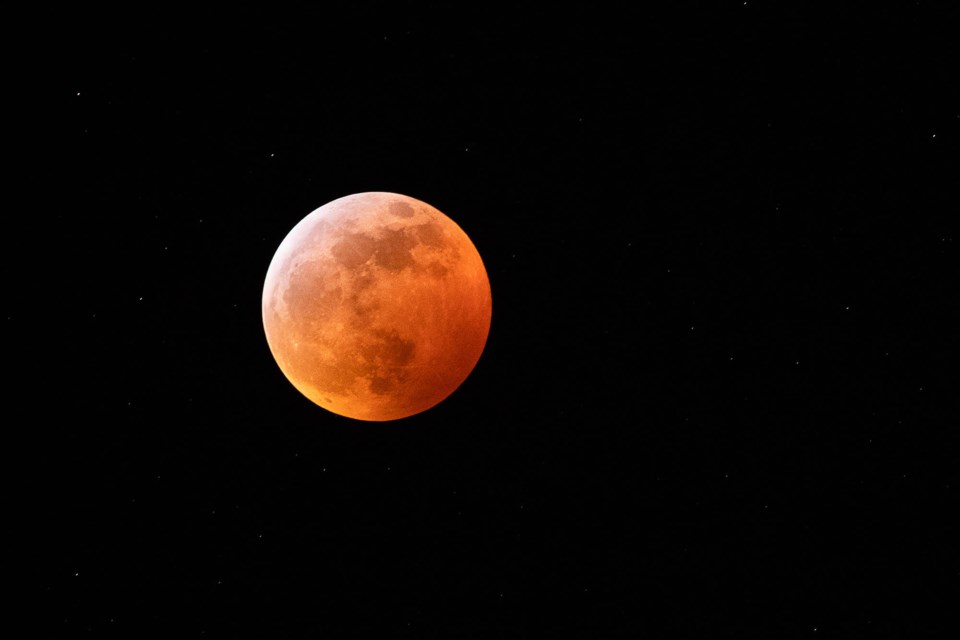The only total lunar eclipse this year and next came with a supermoon bonus. On Sunday night, the moon, Earth and sun lined up to create the eclipse, which was visible throughout North and South America, where skies were clear. There won't be another until the year 2021. It was also the year's first supermoon, when a full moon appears a little bigger and brighter thanks to its slightly closer position. The entire eclipse took more than three hours. Totality — when the moon's completely bathed in Earth's shadow — lasted an hour.
During a total lunar eclipse, the eclipsed, or blood, moon turns red from sunlight scattering off Earth's atmosphere. Besides the Americas, the entire lunar extravaganza could be observed, weather permitting, all the way across the Atlantic to parts of Europe. — The Associated Press
= = =
Update: Skies are largely clear in Greater Victoria tonight and there's a good view of the moon. Lunar eclipse begins about 6:30 p.m. PST. Totality is between 8:42 and 9:44 p.m. University of Victoria observatory is hosting an open house 6:30 to 10:30 p.m. PST to watch the eclipse; Bob Wright Centre, 5th floor.
Story: On Sunday night, a total lunar eclipse will bathe a supermoon in glowing deep red hues. Weather permitting, the lunar eclipse will be visible all over North America and South America, said Karun Thanjavur, a senior astronomy lab instructor at the University of Victoria. “This particular lunar eclipse will be more of a spectacle. It will be very impressive visually and people will actually see it happen,” Thanjavur said. “Conveniently, the lunar eclipse happens early in the evening when little children will be up. That’s what makes this lunar eclipse so exciting. It’s something people can share.”
A lunar eclipse is created by the shadow of Earth falling on the moon. This can happen only when the sun, the moon and Earth are perfectly aligned during a full moon, Thanjavur said.
The eclipse will begin around 6:30 p.m. By 8:40 p.m., stargazers will be able to see the lunar eclipse — sometimes called a blood moon for the reddish colour the moon takes on when Earth’s shadow falls on it.
If skies are clear, people will see a big, bright, full moon rising into the sky.
“They call it a supermoon because it’s marginally closer to Earth in its elliptical orbit and it will be slightly bigger than the usual full moon,” Thanjavur said.
About 6:30 p.m., the penumbra or lighter outer shadow of Earth will begin falling on the moon. The moonlight will be dimmer, but it will still be fairly bright, Thanjavur said.
About 8:40 p.m. the umbra or inner darkest part of Earth’s shadow will fall on the moon and it will become dark and appear reddish.
The reddening of the moon comes from sunlight passing through Earth’s atmosphere. It’s similar to what happens at sunrise and sunset, when the sun appears red in colour, Thanjavur said.
“That’s because the sunlight, as it passes through the atmosphere, gets scattered by dust particles. These dust particular scatter blue light in the sunlight so only the red light comes to our eyes,” he said.
At the end of the umbral eclipse, it will go back to the penumbral eclipse and the moon will gradually become brighter and brighter. By about 10:30 p.m., it will become a full moon again, Thanjavur said.
If the weather is good, UVic will host an open house at the observatory on the fifth floor of the Bob Wright Centre from 6:30 p.m. to 10:30 p.m. A telescope will be available for people to look through.
“You can enjoy the lunar eclipse with the naked eye,” Thanjavur said. “It’s very beautiful as it is.
“But if you look at it through a telescope, then you actually get to see the surface features, the craters and the maria. You get to see the moon close up.”
Looking through a telescope at a full moon is usually blindingly bright, he said. “But during an eclipse, because the moon is darker, you’ll be able to look at the moon in a very different perspective. The surface features will all have this reddish hue on them. It’ll be a very different experience.”
The roof can safely accommodate about 200 people at one time. Thanjavur said he’ll try to keep people moving.
“There’s plenty of time for everyone to enjoy it,” he said. “A total eclipse lasts for an hour and two minutes.”
If it’s raining, there won’t be an open house, Thanjavur said. “There’s nothing we can do. We can’t look through clouds.”
• For information and tickets for the open house, go to eventbrite.ca.



